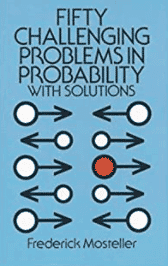Which is better – wealth or ability? Fred Mosteller posed this question in his classic 1965 small compendium Fifty Challenging Problems in Probability, in the context of the Gambler’s Ruin puzzle.
Two players, M and N, engage in a game in which $1 is transferred from one player to the other at each play. Player M has a ⅔ probability of winning each play (more “ability”), but starts out with only $1 (less “wealth”). Player N has a ⅓ probability of winning and starts with $2. Obviously, player M has a ⅓ chance of going bankrupt immediately, but in the ⅔ of cases where they win the first play, does M survive long enough for their superior ability to give them the better chance of escaping long-term bankruptcy?
The answer is yes – ultimately M has a 4/7 chance winning the game (put another way, N has a 4/7 chance of going bankrupt). Mosteller derived this probability from a more general solution for player M’s probability P of winning the game:
P = [1 – (q/p)m] / [1 – (q/p)(m+n)]
where:
m is M’s initial stockpile
n is N’s initial stockpile
p is M’s probability of winning a single play of the game
q is N’s probability of winning a single play of the game
Conclusion (in Mosteller’s words): “It’s better to be twice as good a player than twice as wealthy.”
